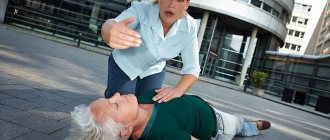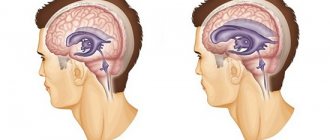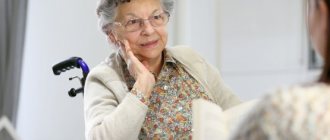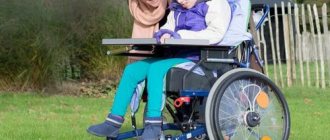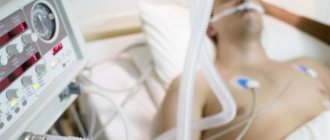More information about other types of diseases starting with the letter “N”: Sleep disturbance; Narcolepsy; Hereditary cerebellar ataxia of Pierre-Marie; Spinal circulatory disorders; Trigeminal neuralgia; Neuralgia of the submandibular and sublingual nodes; Neuralgia of the glossopharyngeal node; Neuralgia of the ear ganglion; Neurasthenia; Neural amyotrophy of Charcot-Marie-Tooth; Acoustic neuroma; Neuroma; Optic neuritis; Pharyngeal neuritis; Neuritis of the facial nerve; Neuritis; Obsessive-compulsive neurosis; Pharyngeal neurosis; Neuroses; Neurosis-like stuttering; Femoral nerve neuropathy.
General concept
Neural amyotrophy of Charcot-Marie-Tooth is a chronic disease of the body that has a hereditary type of formation. A characteristic indicator is damage to the peripheral nervous system. Abnormal processes are manifested in the formation and changes in structure in muscle areas, for example: a decrease in the size of areas at the beginning of the lower extremities, and then the upper ones. In combination with this type of anomaly, the patient may experience hypoesthesia and a decrease in the reflex ability of the tendons, twitching of different parts of the muscles.
Doctors resort to various options for examining a patient with this disease, these include: electromyography, electroneurography, genetic testing, DNA testing, biopsy of nerves and muscle areas. There are no radical treatment methods, but there are methods aimed at ridding a person of symptoms. Doctors prescribe a variety of vitamin complexes, anticholinesterase methods, metabolic techniques, microcirculatory analogues, exercise therapy, physiotherapy, etc.
References
- Nazarov, V.D., Lapin, S.V., Melnik, E.A. et al. Clinical significance of studying the number of copies of the PMP22 gene in patients with motor-sensory polyneuropathy. Neurological Journal, 2021. - No. 3. — P.113-120.
- Likhachev, S.A., Pleshko, I.V., Osadchuk, T.V. Molecular genetic technologies in the diagnosis of hereditary neuropathies. Medical journal, 2009. - No. 3(29). — P.152-154.
- Pantera, H., Shy, M., Svaren, J. Regulating PMP22 expression as a dosage sensitive neuropathy gene. Brain research, 2021. - P. 1726.
Useful information
Neural amyotrophy Charcot-Marie-Tooth (CMT) is included in the list of chronic diseases (polyneuropathies) of a genetic nature that manifest themselves in increased progression. These include:
- Roussy-Lévy syndrome.
- Hypertrophic neuropathy Dejerine-Sotta.
- Refsum's disease and other rarer pathological processes.
According to the average statistical data, scientists state that almost 83% of cases are caused as a result of a person’s hereditary predisposition. Adverse effects in the body occur mostly in men; women are less susceptible to the described disease. Referring to numerous data, neural amyotrophy CMT is diagnosed with a frequency of two to thirty-six cases per hundred thousand of the planet's population. Usually, it is of a family nature. However, among members of the same family, clinical symptoms may be expressed differently. At the same time, doctors also observe sporadic variants of CMT. Medical staff note a clear relationship with Friedreich loss of coordination. Some patients in different situations experience typical symptoms of one or another disease. Sometimes, over many years, the symptoms of one anomaly may be replaced by the symptoms of another.
Pathogenesis of neural amyotrophy Charcot-Marie-Tooth
In medicine at the moment there is no accurate and reliable information about the origin and mechanism of neural amyotrophy. According to the experiments, it became clear only that in almost 75% of patients with this diagnosis who underwent genetic consultation, a repetition of a certain zone of the 17th chromosome was identified. It is already known that the disease has several groups, caused by various gene mutations. For example, during a study of a patient with CMT, which manifests itself due to a mutation in the MFN2 gene protein, mitochondria particles begin to appear. As a result, a person experiences a disruption in the movement of these elements along the axon.
A large number of forms appear due to damage to the myelin outer layer of fibers. Much less often you can notice forms with deviations from the norm of axons - objects of axial direction that pass in the central part of the nervous structure. Abnormal processes can affect the condition of the anterior and posterior processes of the spinal cord, neurons of the anterior horns, Gaulle's pathways and Clark's columns. Again, due to problems with the functioning of the peripheral region, muscle insufficiency begins to form.
Varieties and classification
In the neurological direction of medicine, neural amyotrophy of Charcot-Marie-Tooth is divided into two clear groups, which are clinically quite similar to each other, but have a list of features that allow such a distinction to be made:
- Neural amyotrophy type I - causes a decrease in the speed of nerve impulses.
- ON type II - speed is adversely affected to a lesser extent, neurite deviation is manifested.
What causes lead to the development of Charcot's disease?
The main and only cause of any type of Charcot-Marie-Tooth disease is point mutations in genes.
At the moment, science knows about two dozen genes that undergo changes that subsequently lead to amyotrophy. Most often, “breakdowns” are found in genes located on chromosomes 1 and 8, namely PMP22, MPZ, MFN2, etc. And this is only a part of them. Many remain behind the scenes, so to speak, because about 10-15% of patients do not even know about their illness and do not seek medical help.
The demyelinating type of pathology is also associated with acquired autoimmune aggression, in which the cells that create the outer sheath of the nerve are perceived by the body as foreign and are destroyed.
There are also risk factors that contribute to a more pronounced manifestation of the symptoms of Charcot-Marie-Tooth disease and aggravation of the existing clinical picture.
Triggers of the disease include:
- alcohol consumption;
- use of potentially neurotoxic drugs. For example, vincristine, lithium salts, metronidazole, nitrofurans, etc.
Anesthesia using thiopental is contraindicated for patients suffering from hereditary peroneal amyotrophy.
What are the manifestations of Charcot-Marie-Tooth neural amyotrophy?
With the described disease in humans, the first thing that begins is the formation of similar muscle necrosis in the lower extremities. The first manifestations, as a rule, occur at the age of twenty (much less often, doctors can diagnose symptoms in adolescence from 16 years, and also up to 30 years). Such manifestations consist mainly of a high degree of fatigue of the legs during a long stay in an upright position. The so-called “trampling” syndrome has been noticed, that is, in order for the patient to relieve discomfort, he begins to walk in place. In some rare situations, AN manifests itself as a disorder of the sensitivity of the same parts, most often - paresthesia is formed in the form of crawling goosebumps.
A typical early sign of cervical mastication is the complete absence of Achilles and patellar tendon reflexes. As a result, the patient develops a drooping arch, an inability to walk on his heels, and an abnormal gait that is similar to that of a horse. Subsequently, the harmful process increases the degree of progression further and affects the muscles and flexors. The maximum level of necrosis can lead to complete deformation of the legs with a high arch, similar to the Friedreich foot type. Gradually, CMT moves to the proximal areas, which include the legs and lower thighs. The patient begins to develop serious deformities: drooping feet, legs becoming abnormally shaped. Next, the hands are affected, the hand becomes like a monkey's paw.
It is worth knowing that harmful lesions never affect the muscles of the cervical perimeter, torso and shoulder area. In addition to the above symptoms, the patient may experience the following problems:
- Faint twitching.
- Hypertrophy of the compensatory nature of muscle areas.
- Sensory impairments.
- Possibility of cyanosis and swelling of the skin.
CMT typically develops symptoms slowly. The period of development of the process of reduction in the size of the legs and arms can take up to ten years. Even with such serious deformations of the body, the patient is able to maintain working capacity for a long time and normally perform various household duties. The following factors may precipitate symptoms:
- Entry of infectious agents into the body.
- Long stay in the cold.
- Head injuries.
- Damage to the back and spinal cord.
- Lack of vitamins in the body.
Complications
If you start neural amyotrophy, there may be irreversible consequences. They manifest themselves in the form of respiratory system disorders. If the pathology affects the nerve endings that control the diaphragm. The patient will most likely need to use bronchodilators or artificial ventilation. Being overweight or severely obese can make it difficult for a patient to breathe.
Depression can be due to stressful situations. Most often this occurs due to the progression of the pathology. Both special medications and psychological assistance can be used. If the disease is in an advanced form and without treatment, it will lead to disability.
The patient may stop moving completely and, as a result, deafness may occur. In order to avoid such serious consequences, it is necessary to consult a doctor in a timely manner. He will be able to prescribe a comprehensive diagnostic to make an accurate diagnosis. Only after this will treatment methods be applied. The disease causes chronic motor and sensory polyneuropathy.
Diagnostic options
To diagnose Charcot-Marie-Tooth AN, medical workers rely on such manifestations as:
- The age at which the first signs of the disease appeared.
- Standard clinical picture.
- Similar nature of destruction of the body.
- Slow degree of development of atrophies.
- Increased risk of symptoms.
During a visit to a specialist’s office, a person will undergo a full examination of the body to identify the presence of muscle weakness in the feet and legs, changes, absence or serious decrease in the level of reflex abilities of the Achilles and knee region, hypoesthesia. In order to distinguish CMT from other neuromuscular disorders, doctors create a series of examinations that the infected person will need to undergo. These include:
- Electromyographic study.
- Electroneurography.
- Analysis of blood cells for sugar, hormonal levels and narcotic substances.
- Consultation with a specialist in the field of genetics.
- DNA assessment or genome sequencing (the latter option is very expensive for widespread use).
- Biopsy.

